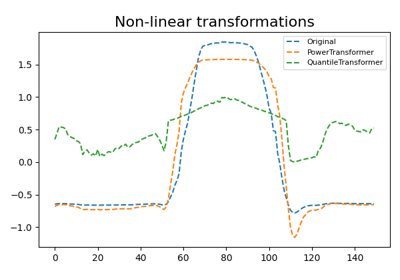pyts.preprocessing.QuantileTransformer¶
-
class
pyts.preprocessing.QuantileTransformer(n_quantiles=1000, output_distribution='uniform', subsample=100000, random_state=None)[source]¶ Transform samples using quantiles information.
This method transforms the samples to follow a uniform or a normal distribution. Therefore, for a given sample, this transformation tends to spread out the most frequent values. It also reduces the impact of (marginal) outliers: this is therefore a robust preprocessing scheme. The transformation is applied on each sample independently.
The cumulative distribution function of a feature is used to project the original values. Note that this transform is non-linear.
Parameters: - n_quantiles : int, optional (default = 1000)
Number of quantiles to be computed. It corresponds to the number of landmarks used to discretize the cumulative distribution function.
- output_distribution : ‘uniform’ or ‘normal’ (default = ‘uniform’)
Marginal distribution for the transformed data. The choices are ‘uniform’ (default) or ‘normal’.
- subsample : int, optional (default = 1e5)
Maximum number of timestamps used to estimate the quantiles for computational efficiency.
- random_state : int, RandomState instance or None, optional (default=None)
If int, random_state is the seed used by the random number generator; If RandomState instance, random_state is the random number generator; If None, the random number generator is the RandomState instance used by np.random. Note that this is used by subsampling and smoothing noise.
Examples
>>> from pyts.datasets import load_gunpoint >>> from pyts.preprocessing import QuantileTransformer >>> X, _, _, _ = load_gunpoint(return_X_y=True) >>> qt = QuantileTransformer(n_quantiles=10) >>> qt.transform(X) array([...])
Methods
__init__([n_quantiles, output_distribution, …])Initialize self. fit([X, y])Pass. fit_transform(X[, y])Fit to data, then transform it. get_params([deep])Get parameters for this estimator. set_params(**params)Set the parameters of this estimator. transform(X)Transform the data. -
__init__(n_quantiles=1000, output_distribution='uniform', subsample=100000, random_state=None)[source]¶ Initialize self. See help(type(self)) for accurate signature.
-
fit_transform(X, y=None, **fit_params)¶ Fit to data, then transform it.
Fits transformer to X and y with optional parameters fit_params and returns a transformed version of X.
Parameters: - X : array-like, shape = (n_samples, n_timestamps)
Univariate time series.
- y : None or array-like, shape = (n_samples,) (default = None)
Target values (None for unsupervised transformations).
- **fit_params : dict
Additional fit parameters.
Returns: - X_new : array
Transformed array.
-
get_params(deep=True)¶ Get parameters for this estimator.
Parameters: - deep : bool, default=True
If True, will return the parameters for this estimator and contained subobjects that are estimators.
Returns: - params : dict
Parameter names mapped to their values.
-
set_params(**params)¶ Set the parameters of this estimator.
The method works on simple estimators as well as on nested objects (such as
Pipeline). The latter have parameters of the form<component>__<parameter>so that it’s possible to update each component of a nested object.Parameters: - **params : dict
Estimator parameters.
Returns: - self : estimator instance
Estimator instance.


